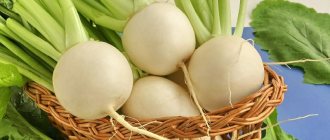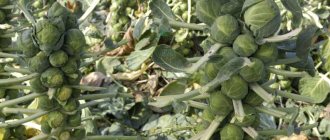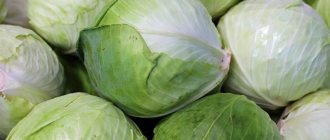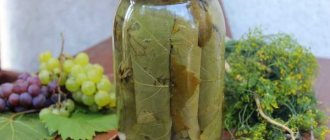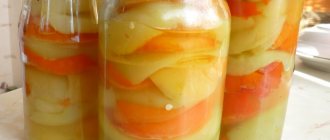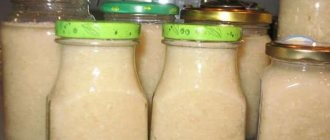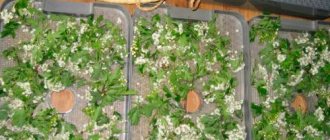This amazing root vegetable has been of interest to experienced cooks for several millennia, as it is used to prepare many popular dishes. Harvesting parsnips for the winter can be done by novice housewives, teenagers and even young chefs. The product is added to soups, borscht and broths. They are used in salads as a delicious seasoning, as well as when pickling cucumbers, tomatoes and soaking apples. Fans of unusual dishes make puree from the root vegetable, which can be served with meat products. Cooks use fresh or dried parsnips to prepare seasonings for vegetable stews or soups.
The popularity of the root vegetable goes back a long way. At the beginning of our era, the Romans prepared honey desserts from it. They were served only to prominent nobles.
Traditional harvesting of parsnips for the winter - drying
Like any other product grown in the garden, this root vegetable is successfully harvested for the winter. The only thing you need to understand is that you can’t just put it in the basement and eat it all season long. For a long time, culinary specialists have been trying to find the most effective option in order to preserve its beneficial properties. The plant is used in the treatment of:
- bronchitis;
- digestive problems;
- of cardio-vascular system;
- hypertension;
- baldness.
As a result, experts have found many interesting recipes for preparing parsnips for the winter, which are relevant in our time. One of them is drying, which our great-grandmothers successfully used a century ago. Let's try to figure out what the secret of this method is.
First of all, the dug parsnips are thoroughly washed away from the soil under strong pressure of water. When the root vegetables are dry, cut them into thin slices (about 5 mm) and place them on a tray in one tier. Next, each housewife uses her own method. These could be the following options:
- drying on the windowsill, where there is a lot of light;
- in a hanging cabinet in the kitchen;
- using an oven (microwave).
To prepare dry parsnips for the winter in the oven, cooks perform several important functions:
- Constantly control the temperature so that the pieces of root vegetables do not burn;
- periodically open the oven door to supply fresh air;
- Stir the parsnip slices constantly;
- The dried fruits are brought to readiness at room temperature.
Housewives who love dried parsnips often prepare the product by placing it in a sunny place. This makes it much easier to control the entire process. If necessary, pieces of the root vegetable are placed in the oven to achieve the desired result.
It is best to store the product in glass jars covered with nylon lids that do not allow air to pass through. If there is a suspicion that pests have appeared in the root segments, you can always dry it in a hot oven.
Drying
Prepared the roots. The tops were removed. Washed. Cleaned it up. Cut it as you like and dry it.
- in ovens with temperatures up to 100 degrees, you will need parchment and 3 or 4 hours for the moisture to disappear from the vegetables;
- special devices, according to instructions;
- you can use a balcony, barn, attic so that it is warm, well ventilated and does not receive direct sunlight.
- on trays in the summer.
After drying, when the vegetables have cooled, you can put them in a dark, dry place at room temperature:
- in linen bags;
- in bags;
- glass jars with tight lids.
Try shaking them occasionally to make the taste even better. Add to first courses. Make sauces, broths, gravies with them.
If you keep dry roots at a temperature of +20 degrees and no higher, then you will be able to use them for a whole year.
Freezing parsnips the modern way
If a housewife has a question: how to preserve parsnips for the winter in the easiest way, she may think about freezing the product. At first glance, it seems that everything is quite simple: dig it up, wash it, cut it, put it in the freezer and do other things. In fact, you can’t do this without diligence.
First of all, the root crop is thoroughly washed so that not a single grain of sand or soil remains on it. Then remove the skin with a sharp knife, after which the fruit is allowed to dry thoroughly. Next, cut it into small circles or cubes. Much depends on the purpose for which the product is prepared.
For soups, prepare cubes measuring one centimeter by one and a half or strips 0.5 cm by 1 cm. To use it for puree, cut it into small wheels.
Parsnips prepared for freezing are placed in plastic bags, the air is released from them, and then packed tightly. For the best effect, the pieces are folded in at least two layers. Thanks to this, the freezing effect will be obvious the next day. The product is used for making soups, purees, sauces and as a component of vegetable salads.
Proper storage – how is it?
Now let's look at ways to preserve parsnips for the winter. There are several of them, and each has a significant difference from the others. The root of this plant is considered the most valuable. By the way, this part is formed in the first year of life, and the color and seeds only in the second. If you have a basement, you can store root vegetables in it. To do this, you should dig it up in late autumn. Be sure to cut off all the tops from the plant and thoroughly dry the part we need. In the meantime, prepare boxes with wet sand. We bury the roots of the parsnip in it and lower it into. The optimal temperature is considered to be from 0 to 1 °C. Oddly enough, the air in the cellar should be as dry as possible.
Many apartment residents cannot boast of having a basement. And if a lot of parsnips have grown on a summer cottage, how to store them in winter in this case? A representative of the flora can easily withstand frosts even in the garden bed, and there is no need to be too tricky with its shelter. It is enough to simply hill up 5 cm of soil. But only in this case you need to hurry up with the spring digging. If you miss the right moment, and the foliage is more than 10 cm, then it is better to leave the resident of the bed for seeds, since its root will become hard, and most of the useful substances will be spent on the development of the ground part. In general, it is recommended to dig up only as many parsnips for outdoor storage as you can eat in winter, and let the rest endure frost in the garden bed.
Drying and freezing parsnips is also popular; we will also look at how to store them in this form for the winter. In both cases, the root must be thoroughly washed and peeled. Then cut it into cubes, small rings or strips. If you want to dry, then lay the pieces in one layer on a sheet of white paper and place in the oven, after drying them from moisture. There it is dried at a temperature of 60 °C.
It is best to leave the oven door open and stir the parsnips constantly. If you spread it on a sieve, it will dry more evenly and faster. You can also use special electric dryers for vegetables and fruits. Pour the finished product into a glass container and seal it tightly, then this preparation is added to numerous recipes as a spice
To freeze, place the chopped pieces in a plastic bag or a special vacuum container and release the air from it. Place the container in the freezer. You can also use cling film for packaging. We tightly envelop a small amount of the root, cut into strips, and place it in the freezer as is.
Delicious delicacy – pickled parsnips
Some housewives prefer to prepare vegetables by canning. To pickle parsnips, cooks use the following products:
- 1 kg of root;
- 250 grams of salt;
- vegetable oil without aroma.
Next, the root vegetable is thoroughly washed, the peel is removed, wiped with a paper towel or allowed to dry at room temperature. The next step is preparing the jars. It is advisable to sterilize them in a steam bath. The product is chopped into strips, rubbed with salt and placed in containers. The top layer of shavings is covered with cotton cloth and filled with vegetable oil to a depth of 15 mm. The jars are then covered with airtight lids and then taken to a cool, dark place.
Original soup dressing
An equally interesting way to prepare parsnips for the winter is as a dressing for hot dishes. To prepare it you will need the following ingredients:
- fresh root vegetables;
- carrot;
- dill;
- parsley;
- celery;
- salt.
For 1 kg of vegetables you need to take approximately 600 g of salt.
Wash greens and parsnips thoroughly under the tap. Let it dry. Vegetables, celery and carrots are cut into small pieces or chopped into strips (can be grated). Parsley and dill are crushed to a pasty state. The ingredients are mixed in a wide bowl. Season with salt. Then put it into steamed jars with a wooden spoon. Cover each container with a piece of foil or parchment paper. The finished product is placed in the refrigerator (you can use the basement). Used as an additional ingredient for hot dishes.
Savory parsnip sauces
An original way to prepare root vegetables for the winter is to prepare an exquisite delicacy from it. Experienced chefs share proven recipes. Let's consider one of them.
Product set:
- half a kilogram of parsnips;
- tomato juice (200 grams);
- sunflower or olive oil (50ml);
- vinegar essence (100 ml);
- salt (2 teaspoons);
- laurel;
- carnation.
Parsnip fruit is boiled in water until soft. They take it out. When it cools down, cut into small pieces and place in a small container. Next, using a blender, grind it to a uniform mass, after which the prepared products from the list are added. Stir and cook over moderate heat for 30 minutes. Then the mass is whipped again with a blender and poured into sterilized jars, which are sealed with lids. The sauce is served with sour cream, broth or olive oil.
LiveInternetLiveInternet
—Categories
- Shouldn't I sew something? (1693)
- We repair clothes. (31)
- Tips on small details. (118)
- Automotive (1)
- Oh, this wedding, she sang and danced. (21)
- Knitting (4364)
- For men. (57)
- Jackets, vests, tops, tunics, boleros, etc. (1738)
- Beautiful Ireland. (36)
- Crochet (2674)
- Machine knitting. (15)
- Bedspreads, blankets, blankets, etc. (89)
- Helpful tips. (490)
- Knitting needles. (1413)
- All kinds of patterns are needed, all kinds of patterns are important. (706)
- Hats, shawls, scarves, stoles, mittens, etc. (873)
- Cooking and eating (12025)
- And no one canceled the post. (108)
- Without salad, neither here nor there. (1485)
- Dishes in pots. (70)
- Fast and tasty. (1075)
- Video recipes. (67)
- Tasty and healthy. (254)
- Delicious without baking. (103)
- Baking - any. (2484)
- The baked goods are unsweetened. (2000)
- Sweet pastries are different. (1155)
- Hot (2399)
- Cooking in a slow cooker. All. (179)
- Cooking for the kids. (16)
- For health (31)
- For unexpected guests. (102)
- We'll make it in the summer and eat it in the winter! (440)
- Shall we have a snack? (1682)
- Casseroles. (520)
- And don’t forget to decorate. (326)
- Summer dishes. (47)
- Liquor-vodka, cheerful. (263)
- Tender, dietary meat - chicken. (812)
- Vegetable. (556)
- Holiday Baking (163)
- Festive and festive. (422)
- Miscellaneous about food. (374)
- Fish. (571)
- Sweets. (221)
- The dough is different. (829)
- Let there be light (candles) (40)
- For my daughter's favorite. (531)
- For myself, my beloved. (2890)
- Home Sweet Home. How cozy it must be. (882)
- Painting. (392)
- Magazines. (249)
- Let's bomb ourselves in the bathroom. (55)
- Let's Take Care of Our Beauty (1897)
- The beauty of hands. (153)
- Face. (578)
- Let's take care of your legs. (190)
- Grow the braid to the waist. (480)
- Body (431)
- From Khakassia - with love. (0)
- History in photographs and more. (254)
- Movie show (53)
- Someday there will be grandchildren - for them (1027)
- Developing (56)
- Comp. And it's all about him. (74)
- Beauty in photographs (99)
- Music flows, music, music. (108)
- Curious, interesting. (132)
- Fashion. (156)
- Prayers, conspiracies, rituals (405)
- Simoron. (225)
- We make soap, we make soap. (127)
- They made me laugh. (94)
- Our house. (94)
- Our rights and obligations (8)
- About cities and countries. (422)
- Oh Woman and . man. (90)
- Oh, this renovation. (131)
- Furniture - alterations. (38)
- Peter - my love (313)
- Let's talk about health (1157)
- Traditional medicine and medicinal herbs. (789)
- Gift. (454)
- PositiFF (224)
- Useful and necessary sites. (74)
- Useful tips (home) (377)
- We wash, we wash, we clean. (237)
- Holidays. (133)
- Are common. (3)
- Festive entertainment. (107)
- Church. (26)
- Festive and decorative. (463)
- Valentine's Day. (40)
- The New Year is rushing towards us. (366)
- Easter. (28)
- Halloween. (14)
- Useful for your diary (301)
- Pictures for comments and more. (139)
- Figure out where. (108)
- Psychology (that's where my thoughts took me) (42)
- Handicrafts (2504)
- Hand-made (165)
- Beads. (2)
- Embroidery. (6)
- Decoupage (86)
- And let's sew something. (346)
- Ideas for the home. (426)
- The art of decoration. (252)
- Patchwork sewing. (42)
- We are from Peredelkino. (143)
- Weaving from newspapers. (20)
- Different - different. (337)
- Let's knit for comfort and beauty. (478)
- Tildochki and toys. (28)
- U.D. - socks, slippers, etc. (322)
- U.D. - pillows, blankets, etc. (427)
- U.D. - potholders, napkins, etc. (187)
- DIY jewelry for yourself and your daughter. (61)
- Poems, parables and all that. (1379)
- Poems - seasons. (94)
- Poems about mom, for mom. (79)
- Something that can be deleted later. (17)
- Amazing things. (15)
- Hacienda (cottage, garden, vegetable garden) (1646)
- All about vegetables. (470)
- Feeding. (fertilize) (80)
- Yagodnik (39)
- Videos (33)
- Greenhouse. (7)
- Animal world (6)
- Houseplants. (158)
- We treat diseases and control pests. (213)
- My dream is a garden. (155)
- Let's build it, decorate it. (367)
- Tips (857)
- Let's save the harvest. (17)
- Flower garden. (309)
- Photoutilities (20)
- I want to lose weight (diets and everything else) (822)
- Physical education is our strength. (361)
Spicy parsnip appetizer
When it's winter, you really want to eat something unusual. Why not try Korean parsnips. To prepare it you will need the following set of components:
- root vegetable (500 grams);
- garlic (several pieces);
- large onion;
- vinegar;
- refined sunflower oil;
- granulated sugar;
- salt;
- spices.
The washed vegetable is peeled and filled with clean water for a few minutes. At this time, they work with the remaining components of the dish: cut the onion into rings, squeeze the garlic through a press. The parsnips are chopped into small pieces, and then salt, sugar, spices, and garlic gruel are added.
Pour sunflower oil into a small container, heat it and sauté the onions in it. The resulting mixture is poured over the parsnips and left for several hours. Vegetables must be thoroughly marinated. At the end of the procedure, vinegar is added, placed in jars, and then placed in the refrigerator or cellar. The appetizer is served with alcoholic drinks as an original treat for guests.
Features of the plant
This biennial plant has long been known to mankind and is famous for its healing properties. It has long been used for bronchitis, heart disease, and weak blood vessels. It is considered the first assistant for colic, improves digestion, and acts as a diuretic. In addition, decoctions from it have long been used to prevent baldness.
Biennial plant with medicinal properties
All this is thanks to the beneficial substances collected in this root vegetable. Among them are potassium, phosphorus, chlorine, sulfur and silicon. It also contains sugar, mineral salts, essential oils and many vitamins and minerals. Therefore, it is very important to please yourself and your family with parsnips in winter; they will be a welcome guest on any table. However, people with light skin tones should treat it with special caution, as it increases its sensitivity to solar radiation.

